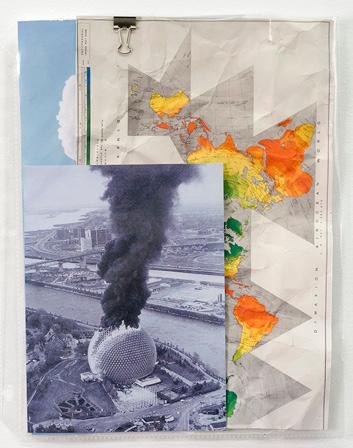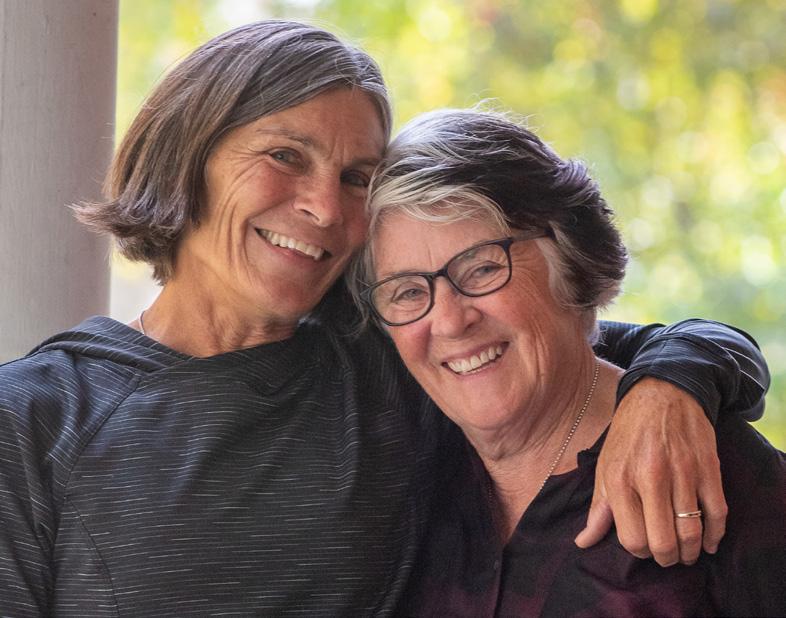
9 minute read
INTO THE WILDERNESS
PAINTER STEVE BUDINGTON’S PROCESS TRUSTS IN THE DETOURS
WEIGHING A QUESTION about research that might precede his work on a painting, Steve Budington pauses to consider. “I think it’s hard to tease that out as a separate event,” he says. “There is not a ‘before the studio, and during the studio, and after the studio.’ It is more of a living organism; it’s never really been a linear progression for me.”
Advertisement
Take the paintings and sketches—some complete, some inprogress—leaning along the walls of the associate professor of art’s office/studio on the ground floor of Williams Hall. The abstractly painted triangular canvases have their origins in Budington’s response to a Buckminster Fuller invention, the Dymaxion world map. But it is not, of course, so simple as “follow point A to point B.” The creative and research processes are intertwined, fed by Budington’s broad curiosity, deep affinity for nature, and keen, ever-vigilant eye on the world.
Budington was a sophomore at the University of Massachusetts-Amherst when he saw a Jasper Johns retrospective that expanded his perspective and aspiration, a pivotal moment in his development as an artist. “You can do that?” Budington recalls thinking. “It was permission to think in this much different way about painting.” Among the works in that exhibition: Map (Based on Buckminster Fuller’s Dymaxion Airocean World).
Fuller’s original variation on a world map produced an image of Earth’s surface projected onto an icosahedron (a twenty-faced polyhedron) that could be unfolded and flattened. Originally created in 1943, Fuller’s later iteration, the 1954 Airocean World Map, is the best-known.
Artist Jasper Johns created Map (Based on Buckminster Fuller’s Dymaxion Airocean World) for the Montreal International and Universal Exposition in 1967, where it was exhibited in the U.S. pavilion, a geodesic dome designed by
BY THOMAS WEAVER
Buckminster Fuller. Budington says that for him the initial intrigue of Johns’s take on Fuller’s map was the unusual shape: triangular canvases fitted together. That intrigue, sparked as a college undergrad, got filed away in memory as his work took other directions through the years.
In ways, Budington has thought about the visual representation of mapping, its challenges and its opportunities, for a long time, most of his life, in fact. Growing up in western New York, Maryland, and Connecticut, he was inclined to spend hours exploring alone, following the banks of rivers or streams where they led. Back home, exploration complete, he would make drawings, “almost imaginary,” Budington says, of where he had trekked. That childhood exercise finds form in the work of the adult artist. “My work is mostly about a relationship to the natural world, somewhere in between the poles of mapping and direct experience,” Budington says.
Several years ago, he again came across the Jasper Johns Map painting that was among the horizon-expanding work he’d first seen as an undergraduate. Intrigue rekindled, he read more about the circumstances around the work, discovering that Johns was initially dissatisfied with his first response to the Dymaxion map.
The artist had worked on the massive painting, fifteen feet high and thirty feet long, in eighteen sections. Since his studio was too small to accommodate them fully assembled, he never saw the work complete until it was installed in Montreal. Johns immediately felt that he’d hugged the shore of Fuller’s work too closely; it was simply a map. When it was returned to him post-Expo ’67, the artist began to rework it and “changed it into a painting.”
Learning of Johns’s unhappiness with that initial map painting, Budington considered what differentiated it from the painter’s target paintings. “If you make a painting of a target, then use it as a target, it’s not really a painting anymore,” Budington says. “And if you use it as a painting, it is not a target. There is a friction there. But in Johns’s first painting of Fuller’s map, that sort of friction wasn’t present.”
The division where representation meets and/or splits from reality has been a theme in Budington’s work throughout his career. His paintings have grown out of his thinking about how science understands the human body versus how we, as individuals, experience our own—sample of one—human body. Or consider a map versus navigating real terrain, Budington says, then ventures into the reality of twenty-first century mapping—navigating in real time in the real world, walking down a city sidewalk, Google Maps open, our own presence a blue dot moving forward.
Budington’s recent paintings echo the shapes of Fuller’s Dymaxion map as a platform for his own exploration. “I’m drawn to the Dymaxion map and other world maps for their utopian desire to create a ‘big picture’ out of things, even as partial views and contingent viewpoints replace such overarching visions today, when the terrain moves around us as we navigate with GPS devices,” he says. “What happens when wholes are replaced by parts, and how do those parts relate to one another?”
Though his process is grounded in faith in improvisation, Budington adds that he prepares himself “with a vocabulary of possibilities.” His triangle-based map paintings are guided
by “direct observations of visual phenomena in the landscape, library research, notes, drawings, and other studies.”
But Budington also shares a Zen-like truth: the work happens within the work. Again, there’s no “ready-set-go” where idea meets canvas; rather ideas evolve and take shape as he paints. “As I work, I keep things unresolved for as long as possible,” Budington says. “I try to find unfamiliar situations, where a chance joining of two colors or a fragment of imagery can take a painting on interesting visual and conceptual detours that wouldn’t otherwise occur. There’s a sense of wilderness in this endeavor, of remaining open, of participating in a kind of travel.”
A similar sense of improvisation is behind a set of clear plastic three-ring binder sleeves, full of images clipped from magazines or his own sketchbook, displayed alongside some of his recent paintings. Something like a visual journal, they are things that have sparked thoughts or caught his eye—an old etching of an explorer falling off an icy cliff; a swath of orange paint; a black-and-white news photo of Bucky Fuller’s geodesic dome in Montreal ablaze, black smoke pouring from the transparent acrylic skin accidentally ignited during a repair in 1976.
Budington has come to see these “assisted documents” as, in and of themselves, works that are complementary to his paintings, examining scientific, cultural, and lived experiences of the natural world. He likens them to the “cut-up” method of artists such as poet William Burroughs, who clipped individual words out of the newspaper and let them fall on the page, or surrealist collage. “These are in that spirit—chance relationships,
loosely assisted without being overly authored,” he says.
Budington followed another avenue of improvisation this summer during a three-week residency through the Hotel Pupik program in Schrattenberg, Austria. At the exhibition/ festival weekend, he played electric guitar in a live performance of experimental music with a percussionist. He’s been invited back for six nights of performance in Vienna and Graz, Austria, this winter, coinciding with an exhibition of his paintings.
Back in Burlington for the opening of fall semester, Budington’s twin pursuits as artist and art professor join in his studio/office in Williams. Though there’s a lot to be said for the quiet and privacy of an off-campus studio, which he had in the past, Budington is finding positives in simplifying to one locale. Paintings in progress are a constant, often seen out of the corner of his eye throughout his days on campus, even when he doesn’t have a brush in hand. “I think that so much artistic work, in a way, happens obliquely; when you’re not thinking about the thing is when you actually solve the problem. I think that’s been good about having my studio right here in Williams,” Budington says.
Also good, the opportunity UVM art majors have to view an accomplished artist’s process on display. “They see that I’m struggling with this, too,” he says. “It is actually hard to make interesting work, and it doesn’t always work out. You fail all the time. Sometimes I’m making disasters happen and the students who walk in here can see that. But that’s also the reality of making artwork.”
Detours, even dead-ends, all essential terrain an artist must learn to navigate.

CLOCKWISE FROM LEFT: partial map with water and partial frame, 2016-19, oil on canvas over wood panels in five parts, wooden frame with enamel, 26” x 90”; assisted document (fall), 2018, found images and cut and folded double sided inkjet print in plastic document sleeve, 11” x 9”; assisted document (Fuller’s plan), 2019, found images in plastic document sleeve with stainless clip, 11” x 9”


Steve Budington received his MFA in painting from the Yale School of Art and his BFA in painting and art history from the University of Massachusetts-Amherst. His work has been exhibited nationally and internationally, including in New York, at Exit Art, Fordham University, and Dorsky Gallery Curatorial Programs; in San Francisco, at Mirus Gallery; in Los Angeles, at Whittier College; and in Italy, at the Fondazione Ambrosetti Arte Contemporanea. The artist received a 2019–20 Vermont Arts Council Creation Grant to support work on a set of paintings shaped after world map projections.
GLOBAL WARMING MORE INSECTS, HUNGRIER FOR CROPS Crop losses for critical food grains will increase substantially with global warming, as rising temperatures boost the metabolism and population growth of insect pests, according to research co-authored by Scott Merrill, research professor in the Department of Plant and Soil Science and Gund Institute for Environment.
Merrill and colleagues at the universities of Colorado and Washington looked at how the insect pests that attack three staple crops—rice, maize, and wheat—would respond under a variety of climate scenarios. They found that rising global temperatures would lead to an increase in crop losses from insects, especially in temperate regions. Losses are projected to rise by 10 to 25 percent per degree of warming.
Just a two-degree rise in global average temperature will result in total crop losses of approximately 213 million tons for the three grains, according to the study, published in Science.
The losses will come from an increase in insect metabolism, and from faster insect population growth rates. The link with metabolism is straightforward. “When the temperature increases, the insects’ metabolism increases so they have to eat more,” says Merrill. “That’s not good for crops.”
The link with population growth, however, is more complex. Insects have an optimal temperature where their population grows best. If the temperature is too cold or too hot, the population will grow more slowly. That is why the losses will be greatest in temperate regions, but less severe in the tropics.
Reduced yields in these three staple crops are a particular concern, because so many people around the world rely on them. Together they account for 42 percent of direct calories consumed by humans worldwide. Increased crop losses will result in a rise in food insecurity, especially in those parts of the world where it is already rife, and could lead to conflict.





PAUL DESLANDES PROFESSOR OF HISTORY







